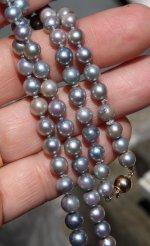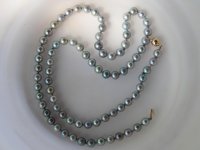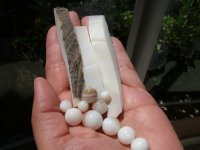Hello I am new to this forum, and have just discovered my new found love for pearls. I never thought i would love pearls so much, but the more i read and the more i play with them, the more i LOVE them.
anyway, a gemologist friend of mine, taught me how to candle pearls with just my iphone. so off i go to candle small but growing pearl collection.
I have a pair of golden akoya pearls, and when i candled them, i could see that there are lines ....as opposed to having a faint nucleus and a glowy nacre.....then on the weekend, i saw a pair of pearl earrings priced very cheaply and so i proceeded to candle them, only to find on the tag it says shell based pearl. lo and behold, it also has lines.....so now i am worried that my supposed akoya pearl studs are immitation.
so how does one tell the difference between genuine pearls as well as man made ones.....i saw one of the members posts showing candling of pearls...and mine did not look like that.....
Thank you in advance.
grace
anyway, a gemologist friend of mine, taught me how to candle pearls with just my iphone. so off i go to candle small but growing pearl collection.
I have a pair of golden akoya pearls, and when i candled them, i could see that there are lines ....as opposed to having a faint nucleus and a glowy nacre.....then on the weekend, i saw a pair of pearl earrings priced very cheaply and so i proceeded to candle them, only to find on the tag it says shell based pearl. lo and behold, it also has lines.....so now i am worried that my supposed akoya pearl studs are immitation.
so how does one tell the difference between genuine pearls as well as man made ones.....i saw one of the members posts showing candling of pearls...and mine did not look like that.....
Thank you in advance.
grace



